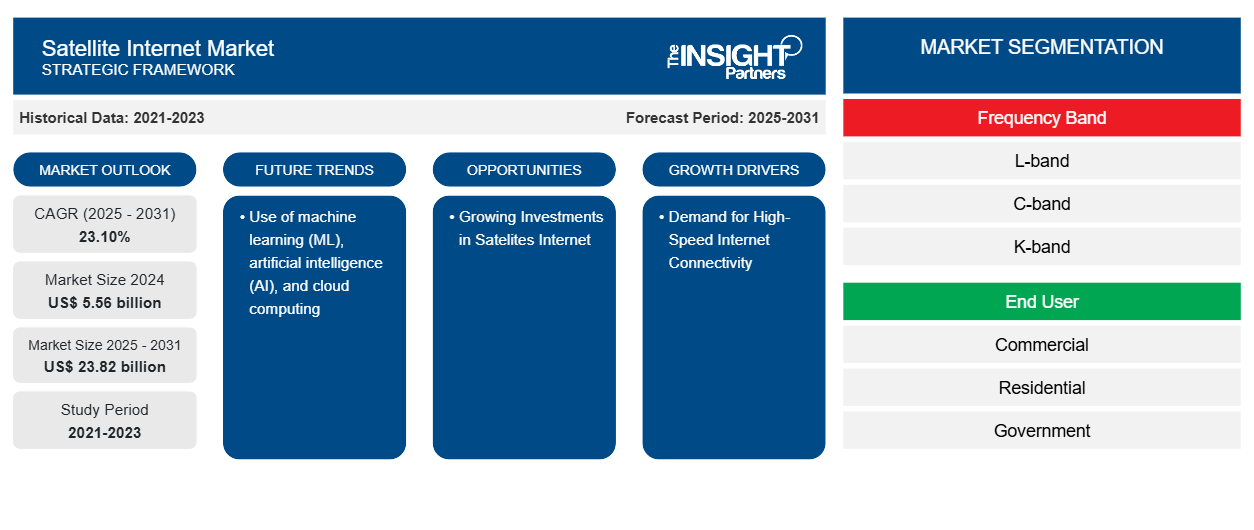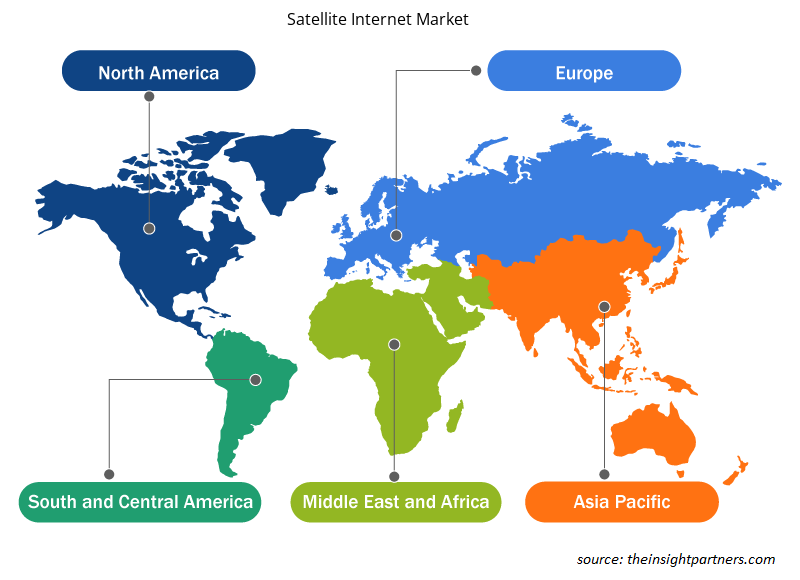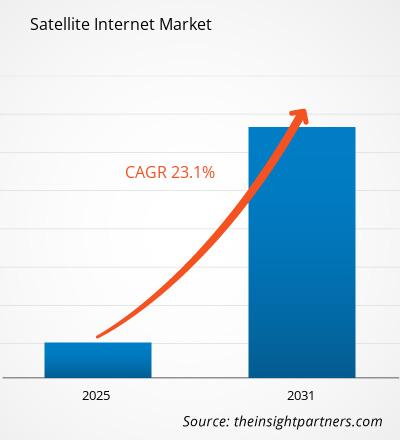The satellite Internet market size is projected to reach US$ 23.82 billion by 2031 from US$ 4.52 billion in 2023. The market is expected to register a CAGR of 23.10% during 2023–2031. The use of machine learning (ML), artificial intelligence (AI), and cloud computing in the space industry are likely to remain key trends in the market.
Satellite Internet Market Analysis
The rising demand for high-speed internet connectivity for homes and offices is one of the major factors boosting the growth of the satellite internet market. In addition, the increasing need for high-speed connectivity for mission-critical and disaster-management applications and inflight Wi-Fi connectivity for commercial aviation and private jets is further boosting the demand for fast satellite internet. Also, the growing investment by the market players in this segment is further fueling the growth of the market. Moreover, the rising need for connectivity for education and infrastructure development projects in rural areas and by researchers and scientists in the Arctic region and oceans is creating an opportunity for the growth of the satellite internet market.
Satellite Internet Market Overview
Satellite internet is the process of accessing the internet through communication satellites, usually geostationary satellites. It is location-independent and provides connection anywhere as it provides global coverage. It is the ideal solution for places where the internet quality is unreliable or poor or places where terrestrial internet connectivity is unavailable. In addition, it is an ideal solution for users who live in rural areas or remote areas. Also, it uses satellite dishes for two-way communication, because of which there is no need for land-based internet solutions such as telephone cables or lines. Moreover, compared to other internet options, it provides less or negligible network outages, making it an ideal option for remote areas.
Customize This Report To Suit Your Requirement
You will get customization on any report - free of charge - including parts of this report, or country-level analysis, Excel Data pack, as well as avail great offers and discounts for start-ups & universities
Satellite Internet Market: Strategic Insights

- Get Top Key Market Trends of this report.This FREE sample will include data analysis, ranging from market trends to estimates and forecasts.
You will get customization on any report - free of charge - including parts of this report, or country-level analysis, Excel Data pack, as well as avail great offers and discounts for start-ups & universities
Satellite Internet Market: Strategic Insights

- Get Top Key Market Trends of this report.This FREE sample will include data analysis, ranging from market trends to estimates and forecasts.
Satellite Internet Market Drivers and Opportunities
Demand for High-Speed Internet Connectivity to Favor Market
The demand for high-speed internet connectivity is on the rise, particularly in non-connectivity areas. This increasing demand can be attributed to several factors, including the need for online education, telemedicine, and e-commerce services. Satellite internet is becoming more accessible and affordable, enabling local entrepreneurs to leverage digital technologies for innovation, job creation, and global market access.
Growing Investments in Satelites Internet
As the need for satellites for high-speed connectivity in rural and remote areas is increasing, the investment for the development and launch of satellites is also growing tremendously. Various government authorities and companies have invested and are investing significantly in market growth. For instance, in November 2021, Fleet Space Technologies announced that they had raised US$ 26 million in funds for the expansion of the nanosatellite IoT connectivity fleet. Similarly, in April 2022, the German parliament announced that they would be investing US$ 10.51 million (10 million euros) in the small satellite initiatives. Also, in July 2023, Amazon announced that it would be investing US$ 120 million to build a satellite construction facility at NASA's Kennedy Space Center as part of its plans to launch a space internet service to rival SpaceX's Starlink.
Satellite Internet Market Report Segmentation Analysis
Key segments that contributed to the derivation of the satellite internet market analysis are frequency band, and end user.
- Based on frequency band, the satellite internet market is bifurcated into L-band, C-band, K-band, and X-band. The K-band segment held a larger market share in 2023.
- By end user, the market is segmented into commercial, residential, and government. The commercial segment held the largest share of the market in 2023.
Satellite Internet Market Share Analysis by Geography
The geographic scope of the satellite internet market report is mainly divided into five regions: North America, Asia Pacific, Europe, Middle East & Africa, and South & Central America.
The market is witnessing tremendous growth due to the presence of various key companies in the region, which includes EchoStar Corporation, SpaceX, Telesat, and others. These market players are continuously working on providing innovative solutions to provide high-speed connectivity in the region. For instance, in July 2023, EchoStar launched a powerful new communications satellite atop a SpaceX Falcon Heavy rocket that will deliver broadband service across nearly 80% of North and South America. Such innovations by the market players will fuel the satellite internet market growth in North America.
Satellite Internet Market Regional Insights
The regional trends and factors influencing the Satellite Internet Market throughout the forecast period have been thoroughly explained by the analysts at The Insight Partners. This section also discusses Satellite Internet Market segments and geography across North America, Europe, Asia Pacific, Middle East and Africa, and South and Central America.

- Get the Regional Specific Data for Satellite Internet Market
Satellite Internet Market Report Scope
| Report Attribute | Details |
|---|---|
| Market size in 2024 | US$ 5.56 billion |
| Market Size by 2031 | US$ 23.82 billion |
| Global CAGR (2025 - 2031) | 23.10% |
| Historical Data | 2021-2023 |
| Forecast period | 2025-2031 |
| Segments Covered |
By Frequency Band
|
| Regions and Countries Covered | North America
|
| Market leaders and key company profiles |
Satellite Internet Market Players Density: Understanding Its Impact on Business Dynamics
The Satellite Internet Market is growing rapidly, driven by increasing end-user demand due to factors such as evolving consumer preferences, technological advancements, and greater awareness of the product's benefits. As demand rises, businesses are expanding their offerings, innovating to meet consumer needs, and capitalizing on emerging trends, which further fuels market growth.
Market players density refers to the distribution of firms or companies operating within a particular market or industry. It indicates how many competitors (market players) are present in a given market space relative to its size or total market value.
Major Companies operating in the Satellite Internet Market are:
- EchoStar Corporation
- SpaceX
- Singtel Group
- Freedomsat
- Viasat Inc
- Inmarsat Global Limited
Disclaimer: The companies listed above are not ranked in any particular order.

- Get the Satellite Internet Market top key players overview
Satellite Internet Market News and Recent Developments
The satellite internet market is evaluated by gathering qualitative and quantitative data post primary and secondary research, which includes important corporate publications, association data, and databases. A few of the developments in the satellite internet market are listed below:
- Intellian Technologies Inc. and OneWeb announced a new product portfolio of Intellian Flat Panel user terminals for use on OneWeb’s network. Intellian’s Flat Panel Series is a suite of both Pro and Compact user terminals that deliver exceptional performance in sleek, small-footprint, and lightweight form factors. It is particularly designed for Land Fixed, Land Mobile, Maritime and Government markets (Source: Intellian Technologies Inc., Press Release, September 2023)
- Astrocast announced that they are extending its partnership with Airbus Defence and Space. The expanded partnership enhances the capabilities of satellite Internet of Things (SatIoT) technology, enabling Astrocast to increase its network capacity to provide SatIoT solutions to its customers. (Source: Astrocast, Press Release, July 2023)
SATELLITE INTERNET Market Report Coverage and Deliverables
The “Satellite Internet Market Size and Forecast (2021–2031)” report provides a detailed analysis of the market covering below areas:
- Satellite Internet market size and forecast at global, regional, and country levels for all the key market segments covered under the scope
- Satellite Internet market trends as well as market dynamics such as drivers, restraints, and key opportunities
- Detailed PEST/Porter’s Five Forces and SWOT analysis
- Satellite Internet market analysis covering key market trends, global and regional framework, major players, regulations, and recent market developments
- Industry landscape and competition analysis covering market concentration, heat map analysis, prominent players, and recent developments for the Satellite Internet market
- Detailed company profiles
Frequently Asked Questions
What is the expected CAGR of the satellite internet market?
The market is expected to grow at a CAGR of 23.1% over the forecast period.
What would be the estimated value of the satellite internet market by 2031?
The estimated value of satleite internet market is expected to reach US$ 23.82 billion by 2031.
Which are the leading players operating in the satellite internet market?
EchoStar Corporation, SpaceX, Singtel Group, Freedomsat, and Viasat Inc. are among the leading satellite internet market.
What are the future trends of the satellite internet market?
The use of machine learning (ML), artificial intelligence (AI), and cloud computing in the space industry are likely to remain key trends in the market
What are the driving factors impacting the satellite internet market?
The demand for high-speed internet connectivity is on the rise, particularly in non-connectivity areas. This increasing demand can be attributed to several factors, including the need for online education, telemedicine, and e-commerce services.
Which region dominated the satellite internet market in 2023?
North America dominated the satellite internet market in 2023.
- Historical Analysis (2 Years), Base Year, Forecast (7 Years) with CAGR
- PEST and SWOT Analysis
- Market Size Value / Volume - Global, Regional, Country
- Industry and Competitive Landscape
- Excel Dataset
- Parking Meter Apps Market
- eSIM Market
- Advanced Distributed Management System Market
- Online Exam Proctoring Market
- Electronic Data Interchange Market
- Barcode Software Market
- Maritime Analytics Market
- Cloud Manufacturing Execution System (MES) Market
- Robotic Process Automation Market
- Digital Signature Market
Testimonials
Reason to Buy
- Informed Decision-Making
- Understanding Market Dynamics
- Competitive Analysis
- Identifying Emerging Markets
- Customer Insights
- Market Forecasts
- Risk Mitigation
- Boosting Operational Efficiency
- Strategic Planning
- Investment Justification
- Tracking Industry Innovations
- Aligning with Regulatory Trends
Yes! We provide a free sample of the report, which includes Report Scope (Table of Contents), report structure, and selected insights to help you assess the value of the full report. Please click on the "Download Sample" button or contact us to receive your copy.
Absolutely — analyst assistance is part of the package. You can connect with our analyst post-purchase to clarify report insights, methodology or discuss how the findings apply to your business needs.
Once your order is successfully placed, you will receive a confirmation email along with your invoice.
• For published reports: You’ll receive access to the report within 4–6 working hours via a secured email sent to your email.
• For upcoming reports: Your order will be recorded as a pre-booking. Our team will share the estimated release date and keep you informed of any updates. As soon as the report is published, it will be delivered to your registered email.
We offer customization options to align the report with your specific objectives. Whether you need deeper insights into a particular region, industry segment, competitor analysis, or data cut, our research team can tailor the report accordingly. Please share your requirements with us, and we’ll be happy to provide a customized proposal or scope.
The report is available in either PDF format or as an Excel dataset, depending on the license you choose.
The PDF version provides the full analysis and visuals in a ready-to-read format. The Excel dataset includes all underlying data tables for easy manipulation and further analysis.
Please review the license options at checkout or contact us to confirm which formats are included with your purchase.
Our payment process is fully secure and PCI-DSS compliant.
We use trusted and encrypted payment gateways to ensure that all transactions are protected with industry-standard SSL encryption. Your payment details are never stored on our servers and are handled securely by certified third-party processors.
You can make your purchase with confidence, knowing your personal and financial information is safe with us.
Yes, we do offer special pricing for bulk purchases.
If you're interested in purchasing multiple reports, we’re happy to provide a customized bundle offer or volume-based discount tailored to your needs. Please contact our sales team with the list of reports you’re considering, and we’ll share a personalized quote.
Yes, absolutely.
Our team is available to help you make an informed decision. Whether you have questions about the report’s scope, methodology, customization options, or which license suits you best, we’re here to assist. Please reach out to us at sales@theinsightpartners.com, and one of our representatives will get in touch promptly.
Yes, a billing invoice will be automatically generated and sent to your registered email upon successful completion of your purchase.
If you need the invoice in a specific format or require additional details (such as company name, GST, or VAT information), feel free to contact us, and we’ll be happy to assist.
Yes, certainly.
If you encounter any difficulties accessing or receiving your report, our support team is ready to assist you. Simply reach out to us via email or live chat with your order information, and we’ll ensure the issue is resolved quickly so you can access your report without interruption.





















 Get Free Sample For
Get Free Sample For